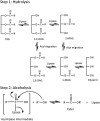Lipase-catalyzed synthesis of red pitaya (Hylocereus polyrhizus) seed oil esters for cosmeceutical applications: process optimization using response surface methodology
- PMID: 35515910
- PMCID: PMC9060793
- DOI: 10.1039/c8ra09418g
Lipase-catalyzed synthesis of red pitaya (Hylocereus polyrhizus) seed oil esters for cosmeceutical applications: process optimization using response surface methodology
Abstract
Esters were synthesized via the alcoholysis of red pitaya seed oil with oleyl alcohol catalyzed by immobilized lipase, Lipozyme RM IM. The effects of synthesis parameters, including temperature, time, substrate molar ratio and enzyme loading, on the yield and productivity of esters were assessed using a central composite response surface design. The optimum yield and productivity were predicted to be about 80.00% and 0.58 mmol h-1, respectively, at a synthesis temperature of 50.5 °C, time of 4 h, substrate molar ratio of 3.4 : 1 and with 0.17 g of enzyme. Esters were synthesized under the optimum synthesis conditions; it was found that the average yield and productivity were 82.48 ± 4.57% and 0.62 ± 0.04 mmol h-1, respectively, revealing good correspondence with the predicted values. The main esters were oleyl linoleate, oleyl oleate, oleyl palmitate and oleyl stearate. The synthesized esters exhibited no irritancy effects and their physicochemical properties showed their suitability for use as cosmeceutical ingredients.
This journal is © The Royal Society of Chemistry.
Conflict of interest statement
There are no conflicts to declare.
Figures








Similar articles
-
High yield lipase-catalyzed synthesis of Engkabang fat esters for the cosmetic industry.Bioresour Technol. 2011 Feb;102(3):2168-76. doi: 10.1016/j.biortech.2010.10.034. Epub 2010 Oct 14. Bioresour Technol. 2011. PMID: 21050749
-
Lipase-catalyzed Production and Purification of Palm Esters Using Stirred Tank Reactors (STR).J Oleo Sci. 2019 Apr 1;68(4):329-337. doi: 10.5650/jos.ess18197. Epub 2019 Mar 13. J Oleo Sci. 2019. PMID: 30867390
-
High-level accumulation of oleyl oleate in plant seed oil by abundant supply of oleic acid substrates to efficient wax ester synthesis enzymes.Biotechnol Biofuels. 2018 Mar 1;11:53. doi: 10.1186/s13068-018-1057-4. eCollection 2018. Biotechnol Biofuels. 2018. PMID: 29507605 Free PMC article.
-
Immobilized Rhizopus oryzae lipase catalyzed synthesis of palm stearin and cetyl alcohol wax esters: optimization by response surface methodology.BMC Biotechnol. 2011 Jun 17;11:68. doi: 10.1186/1472-6750-11-68. BMC Biotechnol. 2011. PMID: 21682865 Free PMC article.
Cited by
-
Ion-Pair Interaction and Hydrogen Bonds as Main Features of Protein Thermostability in Mutated T1 Recombinant Lipase Originating from Geobacillus zalihae.Molecules. 2020 Jul 28;25(15):3430. doi: 10.3390/molecules25153430. Molecules. 2020. PMID: 32731607 Free PMC article.
-
Structure elucidation and docking analysis of 5M mutant of T1 lipase Geobacillus zalihae.PLoS One. 2021 Jun 1;16(6):e0251751. doi: 10.1371/journal.pone.0251751. eCollection 2021. PLoS One. 2021. PMID: 34061877 Free PMC article.
-
Optimisation of Epoxide Ring-Opening Reaction for the Synthesis of Bio-Polyol from Palm Oil Derivative Using Response Surface Methodology.Molecules. 2021 Jan 27;26(3):648. doi: 10.3390/molecules26030648. Molecules. 2021. PMID: 33513686 Free PMC article.
References
-
- Ariffin A. A. Bakar J. Ping Tan C. Abdul Rahman R. Karim R. Chun Loi C. Essential fatty acids of pitaya (dragon fruit) seed oil. Food Chem. 2009;114:561–564. doi: 10.1016/j.foodchem.2008.09.108. - DOI
-
- Gani S. S. A. Kamairudin N. Razalli R. L. Basri M. Phase behaviour study of pitaya seed oil: jojoba oil with non-ionic surfactants in emulsion system. Asian J. Chem. 2015;27:3452–3456. doi: 10.14233/ajchem.2015.18891. - DOI
-
- Gani S. S. A. Basri M. Rahman M. B. A. Kassim A. Rahman R. N. Z. R. A. Salleh A. B. Ismail Z. Engkabang fat esters for cosmeceutical formulation. J. Surfactants Deterg. 2011;14:227–233. doi: 10.1007/s11743-010-1233-4. - DOI
-
- Basri M. Noor R. Raja Z. Rahman A. Ebrahimpour A. Salleh A. B. Gunawan E. R. Basyaruddin M. Comparison of estimation capabilities of response surface methodology (RSM) with artificial neural network (ANN) in lipase-catalyzed synthesis of palm-based wax ester. BMC Biotech. 2007;7:53. doi: 10.1186/1472-6750-7-53. - DOI - PMC - PubMed
-
- Aracil J. Martinez M. Sánchez N. Corma A. Formation of a jojoba oil analog by esterification of oleic acid using zeolites as catalyst. Zeolites. 1992;12:233–236. doi: 10.1016/S0144-2449(05)80288-X. - DOI
LinkOut - more resources
Full Text Sources

